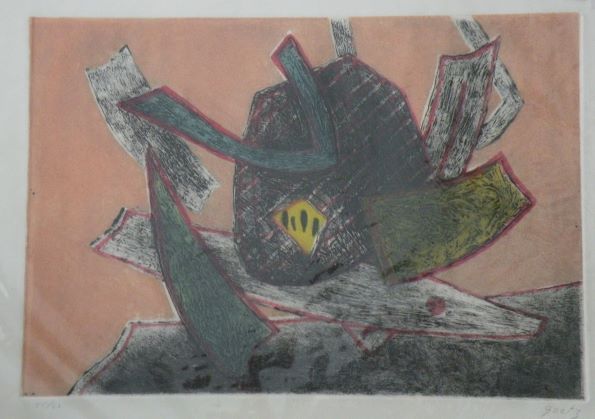
Abstract Still Life by Henri Goetz
This is an abstract intaglio print by Henri Goetz. It uses a printmaking technique he invented called the Carborundum Collagraph. It features intense colors, geometric shapes, and a sense of motion, almost as if the object was caught as it shattered after being dropped. The title is mine, and perhaps Still Life is not all that accurate. It is a vibrant image. It is signed Goetz lower right in pencil. The edition, 55/60 is in pencil lower left. The paper is embossed lower left, Editions Du Damier Paris. A very typical work of this artist.
Henri Bernard Goetz (1909-1989) A French-American artist, Goetz was born in New York City. He had artistic inclinations as a child, which were not encouraged. He studied electrical engineering at the Massachusetts Institute of Technology (his father owned an electrical business), but ended up taking art classes at night. He transferred to Harvard and began taking Art History courses intending to become a museum curator, but eventually decided to pursue a career as an artist. His formal art education began at the Grand Central School of Art in New York City. IN 1930 he moved to Paris to continue his artistic studies attending the Académie Colarossi. He met (and subsequently married) the artist Christine BouMeester at the Académie de la Brande Chaumière. Goetz credits Bourmeester and Victor Bauer for his movement away from realism to abstraction. Artistic influences included Hans Hartung, Fernand Leger and Wassily Kandinsky. He was also influenced by the work of Picasso, Braque, Matisse, and Georges Rouault. During WWII he and his wife worked creating false identify cards for the French resistance, although this work was cut short when several of the group were arrested. After the war, Goetz was involved in many activities in addition to making art. He hosted a radio show called The World of Paris, where he visited the studios of noted artists including such luminaries as Picasso, Kandinsky, Brancusi, Picabia, and Max Ernst. He was a prolific teacher of painting. He and his wife used the medium of etching to illustrate books. He pursued etching using a small press gifted them by Johnny Friedlander. Eventually, he grew frustrated with the traditional printmaking methods and invented a new form of intaglio printing called Carborundum Collagraphy, an extension of the Carborundum mezzotint developed in the 1930s. This technique was embraced by many notable artists including Antoni Clave, Antoni Tapies, and Joan Miro. In 1989, while hospitalized for an illness, he committed suicide by jumping from a 5th floor window.
Goetz held over 100 solo exhibitions throughout Europe and the United States. There have been two major retrospective exhibitions, Cinquante Ans de Creation, Galerie L Obsidienne, Paris 1985 and, shortly after his death, Goetz, Galerie Hanin Nocera, Paris 199. His work is held in major collections including the British Museum, the San Francisco Museum of Art, the Phoenix Art Museum, the Musee National d Art Moderne, Centre Georges Pompidou, Paris, and the Musee Goetz-Boumeester Villefranche-sur-Mer.
Price: $200
Size: 25.75 x 19.75 inches
Plate Size: 18.5 x 12.75 inches
Condition: Pristine
Medium: Aquatint Etching
Subject: Still Life
Shipping, handling and insurance is included for purchases within the US and Canada. We ship internationally. Please contact us for shipping cost and invoice information.

